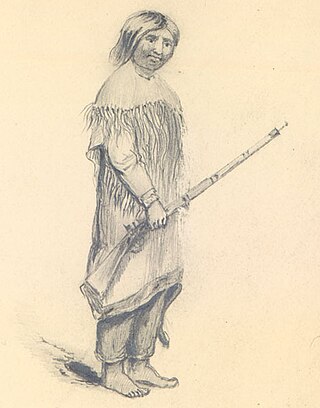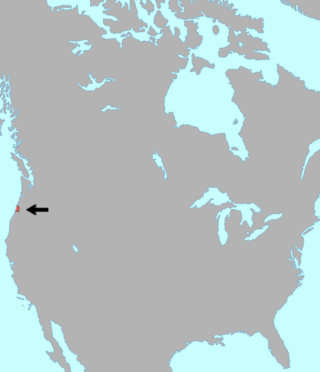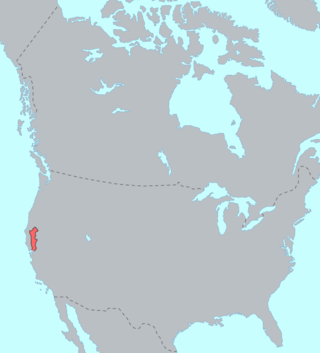Classification
Melville Jacobs (1939) says that the languages are as close as Dutch and German. They share more than half of their vocabulary, though this is not always obvious, and grammatical differences cause the two languages to look quite different.
The origin of the name Coos is uncertain: one idea is that it is derived from a Hanis stem gus- meaning 'south' as in gusimídži·č 'southward'; another idea is that it is derived from a southwestern Oregon Athabaskan word ku·s meaning 'bay'.
Frachtenburg was the first major ethnolinguist to address the relatedness of these languages, saying that Hanis and Miluk were dialects of the same "Kusan" language. [1] Melville Jacobs also said that they were two dialects of the same languages; though he did note that Mrs. Annie Miner Peterson said they were in fact distinct languages and that Miluk had two dialects. [2] In 1916 Edward Sapir suggested that the Coosan languages are part of a larger Oregon Penutian genetic grouping. This analysis has been accepted by some. [3]
However, more recent work has placed Hanis and Miluk as both separate languages and part of their own language family, [4] with Douglas-Tavani doing a comparative reconstruction of Proto-Coosan's phonemes and vocabulary [5]
Siuslaw is one of the tribes comprising the Confederated Tribes of Siletz Indians and a portion of the off-reservation population forms part of the three Confederated Tribes of Coos, Lower Umpqua and Siuslaw Indians located on the southwest Oregon Pacific coast in the United States. Lower Umpqua and Siuslaw are closely related peoples, both of whom spoke dialects of Siuslaw language, a Coast Oregon Penutian language. The Siuslaw language is extinct.
Coos people are an indigenous people of the Northwest Plateau, living in Oregon. They live on the southwest Oregon Pacific coast. Today, Coos people are enrolled in the following federally recognized tribes:

Penutian is a proposed grouping of language families that includes many Native American languages of western North America, predominantly spoken at one time in British Columbia, Washington, Oregon, and California. The existence of a Penutian stock or phylum has been the subject of debate among specialists. Even the unity of some of its component families has been disputed. Some of the problems in the comparative study of languages within the phylum are the result of their early extinction and limited documentation.
Oregon Penutian is a hypothetical language family in the Penutian language phylum comprising languages spoken at one time by several groups of Native Americans in present-day western Oregon and western Washington in the United States. Various languages in the family are divided by dialects that are in most cases identical to the various identified tribal bands in the region.

The Confederated Tribes of the Coos, Lower Umpqua and Siuslaw Indians of Oregon are a federally recognized Native American tribe of Hanis Coos, Miluk Coos, Lower Umpqua, and Siuslaw people in Oregon.

Alsea or Alsean was two closely related speech varieties spoken along the central Oregon coast until the early 1950s. They are sometimes taken to be different languages, but it is difficult to be sure given the poor state of attestation; Mithun believes they were probably dialects of a single language.

Yokuts, formerly known as Mariposa, is an endangered language family spoken in the interior of Northern and Central California in and around the San Joaquin Valley by the Yokuts people. The speakers of Yokuts languages were severely affected by disease, missionaries, and the Gold Rush. While descendants of Yokuts speakers currently number in the thousands, all languages apart from Valley Yokuts are now extinct.

Plateau Penutian is a family of languages spoken in northern California, reaching through central-western Oregon to northern Washington and central-northern Idaho.

Wintuan is a family of languages spoken in the Sacramento Valley of central Northern California.

Kalapuyan is a small extinct language family that was spoken in the Willamette Valley of Western Oregon, United States. It consists of three languages.
The Confederated Tribes of Siletz Indians in the United States is a federally recognized confederation of more than 27 Native American tribes and bands who once inhabited an extensive homeland of more than 20 million acres from northern California to southwest Washington and between the summit of the Cascades and the Pacific Ocean. After the Rogue River Wars, these tribes were removed to the Coast Indian Reservation, now known as the Siletz Reservation. The tribes spoke at least 11 distinct languages, including Tillamook, Shasta, Lower Chinook, Kalapuya, Takelma, Alsea-Yaquina, Siuslaw/Lower Umpqua, Coos, the Plateau Penutian languages Molala and Klickitat, and several related Oregon Athabaskan languages.
Leo Joachim Frachtenberg was an anthropologist who studied Native American languages. Frachtenberg helped write the Handbook of American Indian Languages, BAE Bulletin 40, and also wrote "Alsea Texts and Myths", BAE Bulletin 67.
Annie Miner Peterson (1860–1939) was a Coos Indian from the U.S. state of Oregon who was a cultural and linguistic consultant to Melville Jacobs, an anthropologist at the University of Washington.

Siuslaw was the language of the Siuslaw people and Lower Umpqua (Kuitsh) people of Oregon. It is also known as Lower Umpqua. The Siuslaw language had two dialects: Siuslaw proper (Šaayušƛa) and Lower Umpqua (Quuiič).
The Coast Oregon Penutian languages are a proposed family of three small languages or language clusters on the Oregon Coast that has moderate support. Although much of their similarity is demonstrably due to language contact, linguists such as Scott DeLancey believe they may be genealogically related at a greater time depth. They are part of the much more hypothetical Penutian proposal.

Lorane is an unincorporated community in Lane County, Oregon, United States. It is located on Territorial Road about 20 miles (32 km) southwest of Eugene; it is 13 miles (21 km) northwest of Cottage Grove. The community is near the headwaters of the North Fork Siuslaw River in a valley in the foothills of the Central Oregon Coast Range. Local businesses include several wineries, including the King Estate Winery, Chateau Lorane Winery and Iris Hill Winery, and two general stores.
Upper Umpqua is an extinct Athabaskan language formerly spoken along the south fork of the Umpqua River in west-central Oregon by Upper Umpqua (Etnemitane) people in the vicinity of modern Roseburg. It has been extinct for at least fifty years and little is known about it other than it belongs to the same Oregon Athabaskan cluster of Pacific Coast Athabaskan languages as the Lower Rogue River language, Upper Rogue River language and Chetco-Tolowa.
Miluk, also known as Lower Coquille from its location, is one of two Coosan languages. It shares more than half of its vocabulary with Coos proper (Hanis), though these are not always obvious, and grammatical differences cause the two languages to look quite different. Miluk started being displaced by Athabascan in the late 18th century, and many Miluk shifted to Athabascan and Hanis.
Hanis, or Coos, was one of two Coosan languages of Oregon, and the better documented. It was spoken north of the Miluk around the Coos River and Coos Bay. The há·nis was the Hanis name for themselves. The last speaker of Hanis was Martha Harney Johnson, who died in 1972. Another speaker was Annie Miner Peterson, who worked with linguist Melville Jacobs to document the language.
The Takelma–Kalapuyan languages are a proposed small language family that comprises the Kalapuyan languages and Takelma, which were formerly spoken in the Willamette Valley and the Rogue Valley in Oregon.









